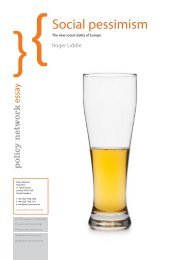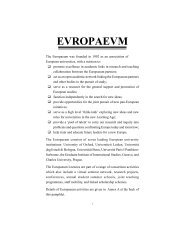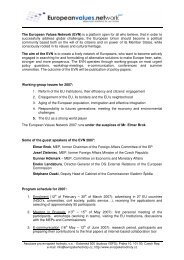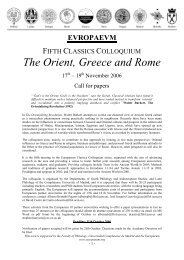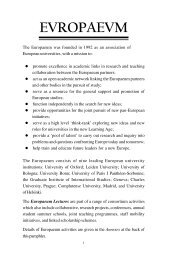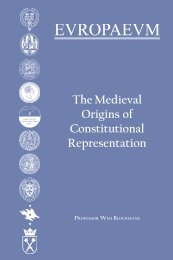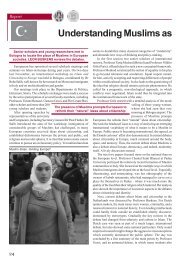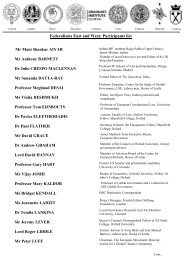Authors Iain Begg | Gabriel Glöckler | Anke Hassel ... - The Europaeum
Authors Iain Begg | Gabriel Glöckler | Anke Hassel ... - The Europaeum
Authors Iain Begg | Gabriel Glöckler | Anke Hassel ... - The Europaeum
Create successful ePaper yourself
Turn your PDF publications into a flip-book with our unique Google optimized e-Paper software.
flexible labour regulation than countries like Finland or Germany, where<br />
the value of capitalisation is less and information networks between banks<br />
and firms’ management are more dense. 8<br />
Different institutional complementarities, however, do not imply a<br />
different capacity to cope with globalisation pressures. On the contrary,<br />
different economies will develop responses depending on their countryspecific<br />
comparative advantage. In other words, the VoC predicts<br />
that countries will react differently to similar pressures, meaning that<br />
globalisation is unlikely to result in convergence towards a single economic<br />
model. 9 Another important result of the VoC is that there appears to be no<br />
systematic difference between LMEs and CMEs in terms of overall income<br />
levels and growth rates. However, LMEs tend to have higher participation<br />
rates in the labour market and a more unequal income distribution,<br />
compared to CMEs. Additionally, the two ideal-types of capitalist<br />
economies will tend to specialise in different patterns of innovation and<br />
competition and therefore in different industrial sectors.<br />
In LMEs, the higher degree of flexibility and mobility with market-based<br />
modes of firm relations incentivises radical forms of innovation, and<br />
strategies based on price competition. In CMEs, in contrast, cooperation<br />
between capital and labour lends itself to incremental forms of process<br />
and product innovation, as well as quality-based competition strategies.<br />
<strong>The</strong>se diametrically opposed incentives result in different comparative<br />
advantages so that, in the traded sector, CMES and LMEs tend to specialise<br />
in different industries and to develop patents on different categories of<br />
goods.<br />
Under this framework, policymakers must pay due regard to the<br />
implications of economic reform for different spheres of the political<br />
economy. To put it simply, the interplay between institutions implies that<br />
a limited number of combinations are both feasible and optimal.<br />
Lisbon through the looking glass<br />
<strong>The</strong> VoC approach, it is important to recognise, would be ambivalent about<br />
the very idea of the Lisbon Strategy. According to this school of political<br />
economy, the competitive advantage of economies blossoms from the<br />
bottom up rather than thriving from the top down, leaving little room for<br />
government intervention. As such, attempts by EU policymakers to “build<br />
a knowledge-based economy” and, latterly, to foster “growth and jobs”<br />
would smack of government overreach for proponents of VoC. Similarly,<br />
the focus on national economies as a key unit of analysis means that<br />
118<br />
After the crisis: A new socio-economic settlement for the EU



